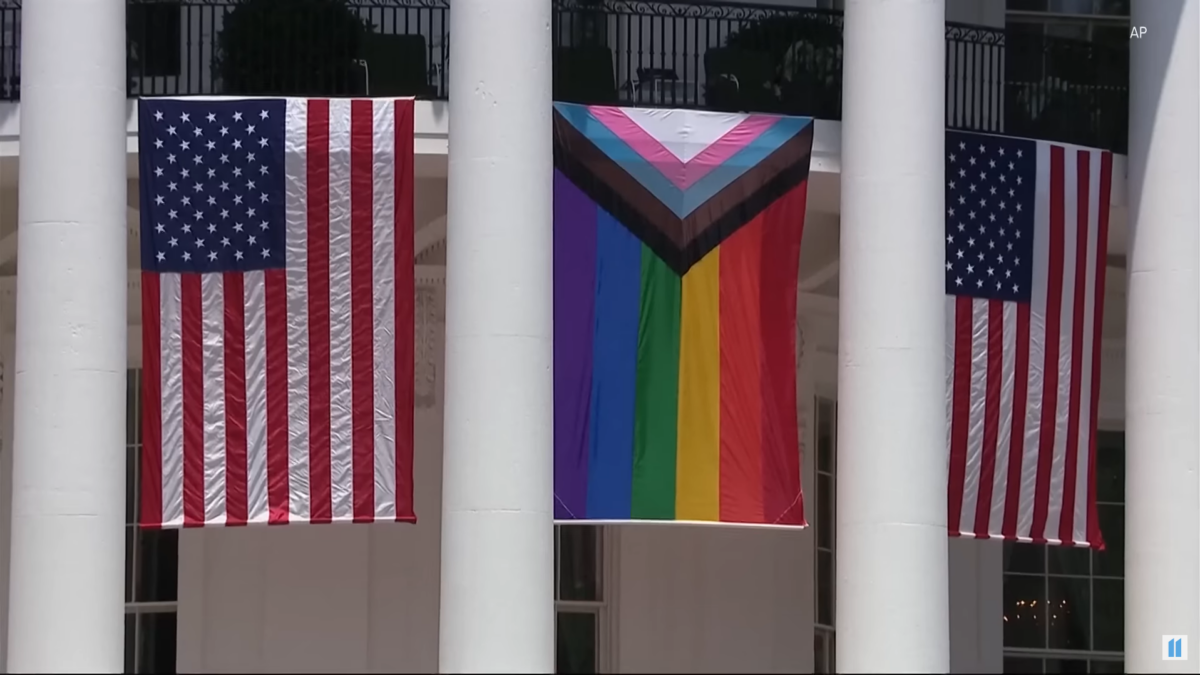For the first time since the British raised the Union colors over a burning Washington in 1814, the White House sits under a foreign battle flag.
Over the weekend, President Joe Biden relegated the Stars and Stripes to flank another banner, hung in the center of the presidential mansion’s South Portico. The so-called “progress pride” flag — the new, extra-garish version of the LGBT rainbow flag that features pink and blue “transgender” stripes as well as black and brown stripes representing racial identities — demanded allegiance from its central position at the White House.
There’s nothing new about federal bureaucrats pushing their cultural agenda on the American people. But the jarring visual from Saturday reminds us there’s only room for one flag at the top of a flagpole. Man cannot serve two masters; countries cannot unite under two flags.
The observation that the rainbow alliance is ascendant as our new state religion has been made aplenty, but is no less true. My colleague John Daniel Davidson has called it “pagan America,” and he’s right. The reigning LGBT ideology operates as a religion in that its disciples look to it for a telos as well as an identity. It has its own crusaders, its own missionaries, and its own sacred texts.
But unlike most national religions, which exist in compatible tandem with their people’s political constitutions, this one cannibalizes its progenitors.
The colorful flag hoisted over the White House represents a militant ideology that is utterly incompatible with the beliefs for which the American flag has traditionally stood.
An Emblem of Self-Indulgence
The “progress pride” flag stands for a belief system that categorizes people based on their attributes and membership in protected classes. Those classes aren’t just sexual, either; bizarrely, the flag representing various sexual behaviors now includes black and brown stripes for skin colors, highlighting the dissonance of an intersectionality that identifies people by both their sexual decisions and physical characteristics, and clumsily lumps them together as “allies.”
Not only does the alphabet agenda segregate its adherents by the colors of the rainbow, but it also commands them to indulge themselves. The most vulgar actions are celebrated when done in the service of individualist desires and self-expression.
If you believe that all America has ever stood for is libertinism — an individual’s license to pursue his every desire, unmoored from religious and civic duties — then this new social ethic is perfectly consistent. It is the natural conclusion of, as Patrick Deneen writes in his book Why Liberalism Failed, “redefining liberty as the liberation of humans from established authority, emancipation from arbitrary culture and tradition, and the expansion of human power and dominion over nature through advancing scientific discovery and economic prosperity.”
This modern concept of liberty, Deneen continues, “increasingly approve[s] nearly any technical means of liberating humans from the biological nature of our own bodies,” which aptly describes the transgender movement’s favorite “remedies” to the natural physical world. And by the leftist understanding of the American Constitution, nothing could be more American than the rainbow flag.
An Emblem of Self-Governance
However, if you believe that freedom has a more profound purpose and that America has ever stood for anything more than personal gratification, then you feel the discordance between the flag flying front and center at the White House and the flag flanking it. There are legitimate arguments to be made about whether the American experiment, relying as it did on a sinful populace to be noble, was ever sustainable — but at the heart of the founding was a vastly different understanding of liberty than what is now paraded as the same virtue.
At its best, America represented an ethic that allowed a man to live free from compulsions that violated his conscience or restricted him from living well; it was for this reason the Puritans fled the Old World for the New. Being freed from the oppression of tyrants, each man and woman might worship freely, work freely, teach their children freely, and ultimately govern themselves.
Governance, of course, necessitates wisdom and discipline. Self-governance, by definition, entails responsibilities. The crucial disconnect between the two flags is that one represents self-indulgence and the other represents self-governance; the two cannot peacefully coexist.
Why? Because at the root of successful self-governance is, as Deneen says, “the ancient conception of liberty as the learned capacity of human beings to conquer the slavish pursuit of base and hedonistic desires” — in other words, to conquer self-indulgence.
“This kind of liberty,” he continues, “is a condition of self-governance of both city and soul, drawing closely together the individual cultivation and practice of virtue and the shared activities of self-legislation.”
If we hope to preserve — or rather, regain — our self-governance, we have no choice but to eschew the new state-enforced ethos of self-indulgence. A man cannot be ruled by both, and neither can a country.








